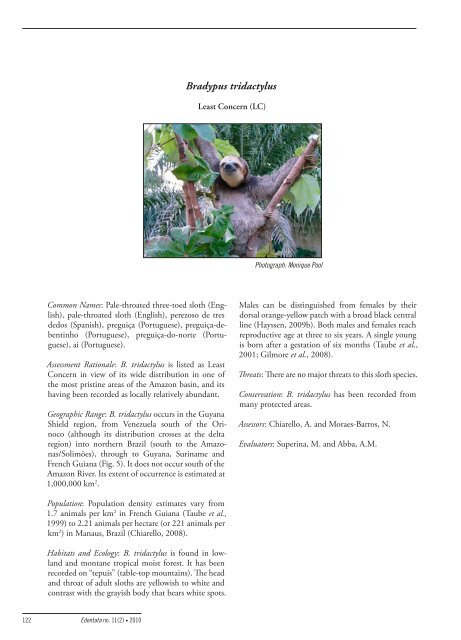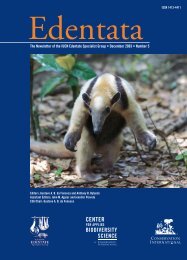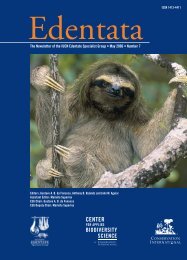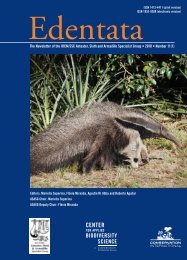Edentata 11(2), 2010 - Anteater, Sloth & Armadillo Specialist Group
Edentata 11(2), 2010 - Anteater, Sloth & Armadillo Specialist Group
Edentata 11(2), 2010 - Anteater, Sloth & Armadillo Specialist Group
- No tags were found...
You also want an ePaper? Increase the reach of your titles
YUMPU automatically turns print PDFs into web optimized ePapers that Google loves.
Bradypus tridactylusLeast Concern (LC)Photograph: Monique PoolCommon Names: Pale-throated three-toed sloth (English),pale-throated sloth (English), perezoso de tresdedos (Spanish), preguiça (Portuguese), preguiça-debentinho(Portuguese), preguiça-do-norte (Portuguese),ai (Portuguese).Assessment Rationale: B. tridactylus is listed as LeastConcern in view of its wide distribution in one ofthe most pristine areas of the Amazon basin, and itshaving been recorded as locally relatively abundant.Geographic Range: B. tridactylus occurs in the GuyanaShield region, from Venezuela south of the Orinoco(although its distribution crosses at the deltaregion) into northern Brazil (south to the Amazonas/Solimões),through to Guyana, Suriname andFrench Guiana (Fig. 5). It does not occur south of theAmazon River. Its extent of occurrence is estimated at1,000,000 km 2 .Males can be distinguished from females by theirdorsal orange-yellow patch with a broad black centralline (Hayssen, 2009b). Both males and females reachreproductive age at three to six years. A single youngis born after a gestation of six months (Taube et al.,2001; Gilmore et al., 2008).Threats: There are no major threats to this sloth species.Conservation: B. tridactylus has been recorded frommany protected areas.Assessors: Chiarello, A. and Moraes-Barros, N.Evaluators: Superina, M. and Abba, A.M.Population: Population density estimates vary from1.7 animals per km 2 in French Guiana (Taube et al.,1999) to 2.21 animals per hectare (or 221 animals perkm 2 ) in Manaus, Brazil (Chiarello, 2008).Habitats and Ecology: B. tridactylus is found in lowlandand montane tropical moist forest. It has beenrecorded on “tepuis” (table-top mountains). The headand throat of adult sloths are yellowish to white andcontrast with the grayish body that bears white spots.122<strong>Edentata</strong> no. <strong>11</strong>(2) • <strong>2010</strong>














